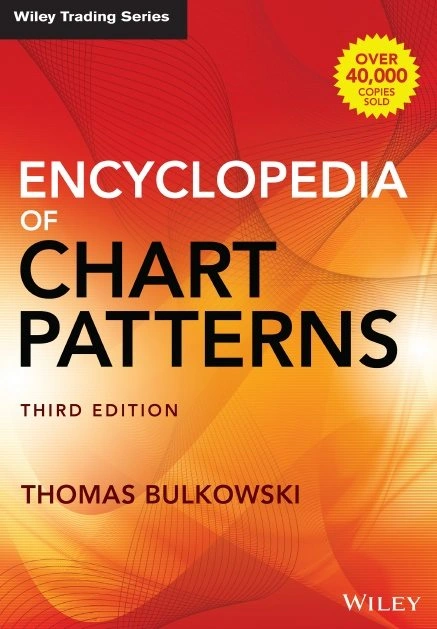Decades of trading research show the triple-bottom pattern has an 87% success rate in bull markets and an average profit potential of +45%.
The triple-bottom chart pattern should be used more by traders because it is reliable and accurate and generates one of the highest profits per trade of all patterns.
Learn how to identify and trade the triple bottom to improve your chances of trading success.
KEY TAKEAWAYS
- The triple-bottom pattern has a reliability of 87% in testing 1.
- The average price increase during a bull market is 45%.
- The triple-bottom has a strong horizontal resistance.
- It is most profitable to trade during bull markets.
- Wait for a confirmation bounce on the third bottom before trading.
What Is a Triple Bottom Chart Pattern?
The triple bottom chart pattern is a technical analysis trading strategy in which the trader attempts to identify a reversal point in the market. Traders look for three consecutive low points separated by intervening peaks, creating a “VVV” shape on the price chart.
The triple bottom chart pattern is considered a reliable reversal point in the market, with an 87% success rate in bull markets. This is because when the price breaks above the intervening peaks, buyers begin to take control of the market, and the trend could change from bearish to bullish.
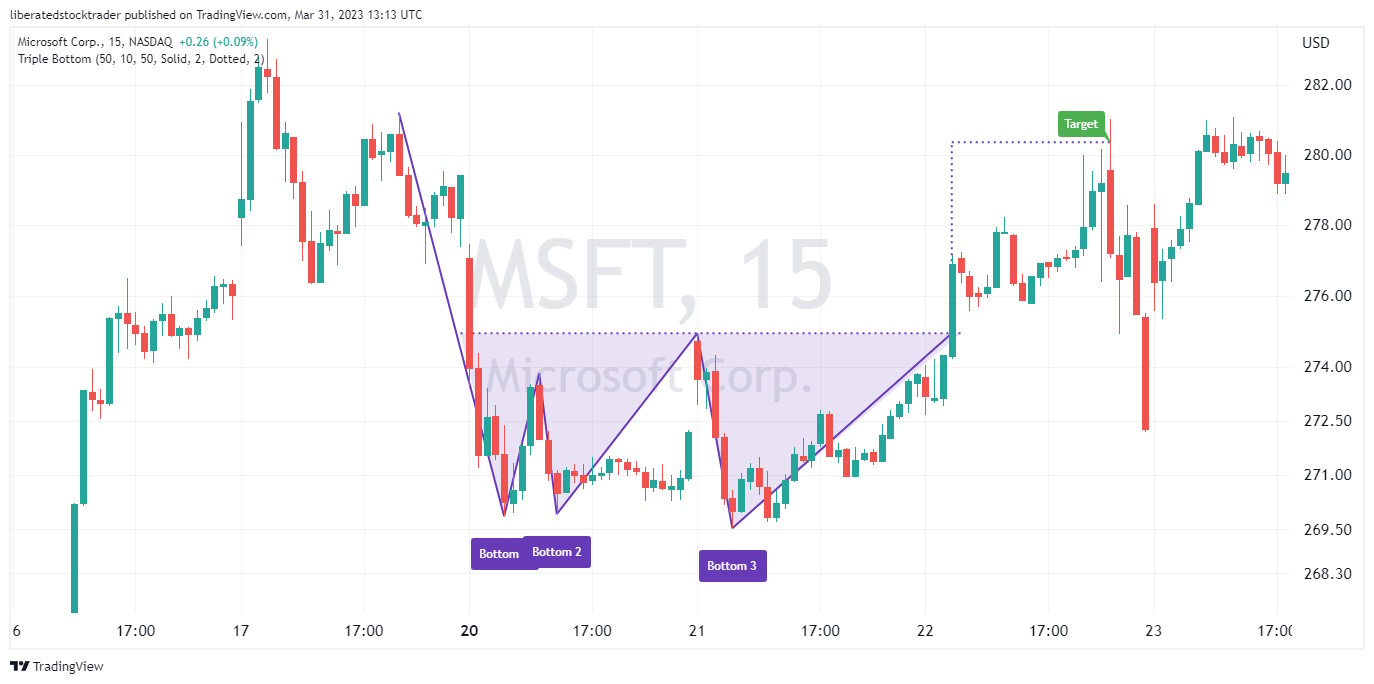
Auto-detect this Chart Pattern with TradingView
How to Identify a Triple Bottom?
To identify a triple bottom chart pattern, look for three distinct lows in the security’s price that form a “VVV”-shaped pattern. Generally, the pattern should be visible on an intraday and daily chart. Triple bottoms occur more frequently on 15-minute and hourly charts.
After identifying the three bottoms, look for a confirmation of a trend reversal by watching for a breakout either above the upper resistance line/neckline or below the bottoms. If the security price breaks out above the neckline line, especially with volume increases, it signals that the security has completed its reversal and has an 87% of going higher.
In contrast, a break below the support line could signal a resumption of the downtrend. However, further confirmation of this stock chart pattern should not be relied upon until prices have moved beyond these levels.
How to Trade a Triple Bottom Chart Pattern
To trade triple bottom chart patterns, look for a stock that has formed three consecutive low points with intervening peaks. Once the price breaks above the intervening peak’s neckline, enter a long trade. Set a stop loss below the neckline. The target can be determined by measuring the height of the lows and setting the target at that distance above the neckline.
Traders should pay attention to volume when trading a triple-bottom chart pattern. Higher volume on the breakout is often considered a confirmation of trend reversal in this setup (see above chart). This means traders should be vigilant and wait for higher volumes before entering a trade on any breakout situation.
Triple Bottom Entry and Exit Points
The entry point for a triple bottom pattern is at the break of the resistance neckline after the third bottom. Traders should place a stop-loss order below the neckline to protect against potential losses. The exit point can be determined by placing an initial target near the resistance level/neckline and then trailing stops behind it until the trend reverses. (See Chart Above)
It is also important to remember that triple bottoms can fail at a rate of 13%, and traders should always have an exit strategy in case of a failed pattern. Furthermore, managing risk during any trade is essential, as the potential for loss is still real. Using proper risk management techniques, traders can maximize profits while limiting losses.
My thorough testing awarded TradingView a stellar 4.8 stars!
With powerful stock chart analysis, pattern recognition, screening, backtesting, and a 20+ million user community, it’s a game-changer for traders.

Whether you're trading in the US or internationally, TradingView is my top pick for its unmatched features and ease of use.
Explore TradingView – Your Gateway to Smarter Trading!
How Reliable is a Triple Bottom Pattern?
A triple-bottom stock chart pattern has an 87% success rate on a reversal of an existing downtrend. When the price breaks through resistance, it has an average 45% price increase.
The triple bottom occurs when the security price hits the bottom three times, creating a “VVV”-shaped pattern. This pattern often indicates that the security price could soon increase. However, it should be noted that this indicator does not guarantee a reversal in direction.
| Chart Pattern | Success Rate | Average Price Change |
| Triple Bottom | 87% | 45% |
The Triple Bottom Pattern Timeframe
Triple bottoms can form on any timeframe, from intraday to weekly charts. However, they are relatively rare and mostly found on intraday charts, 1, 5, or 15-minute time frames. This makes the triple bottom a great pattern for day traders.
The triple bottom pattern typically takes hours or even days to form. Traders should monitor the stock over a medium-term period on an hourly or daily chart and be prepared to enter at any time to maximize potential profits.
It is important to consider volume as an additional indicator when attempting to identify and trade the triple bottom pattern.
What Happens After Triple Bottom Pattern?
Two decades of research by Tom Bulkowski shows that after a triple bottom pattern is confirmed on a break of the neckline on higher volume, the price increase averages +45%.
Once the triple bottom pattern is confirmed, traders should consider opening a long position near the support area and placing a stop-loss order below the lower low. This will help them better manage their risk as they enter a potential trade.
What Happens with a Failed Triple Bottom Pattern?
A triple bottom in a bull market fails 13% of the time. When a triple bottom pattern fails, the stock price falls below the neckline support and continues to decline. This can be used as an opportunity for traders to short-sell and place stop-loss orders at the support level. Proper risk management is essential to capitalize on failed patterns to limit losses.
A Triple Bottom Pattern in an Uptrend
The triple bottom can also form within an existing uptrend in a bull market. This is usually a sign of strength and often results in the continuation of the uptrend. Traders should be aware that this pattern may provide false signals, as it does not guarantee that the trend will continue, and prices could reverse at any time.
How to Measure a Triple Bottom Price Target.
If the distance from the trough to the neckline is 10%, the logical price target should be 10% above the neckline. It is calculated by adding the pattern’s height to the breakout point. This gives traders a good indication of where to expect prices to move following a successful breakout. Once the triple bottom breakout is confirmed, traders should set their stop-loss order just below the neckline.
In the chart above, you can see the height/depth of the triple bottom is equal to the price target.
How to Automatically Identify Triple Bottoms?
You can automatically identify triple bottom patterns using TradingView. Go to TradingView and click Indicators > Technicals > Patterns. Next, select Triple Bottom Chart Pattern. Now, a chart with a triple bottom pattern will be clearly marked.
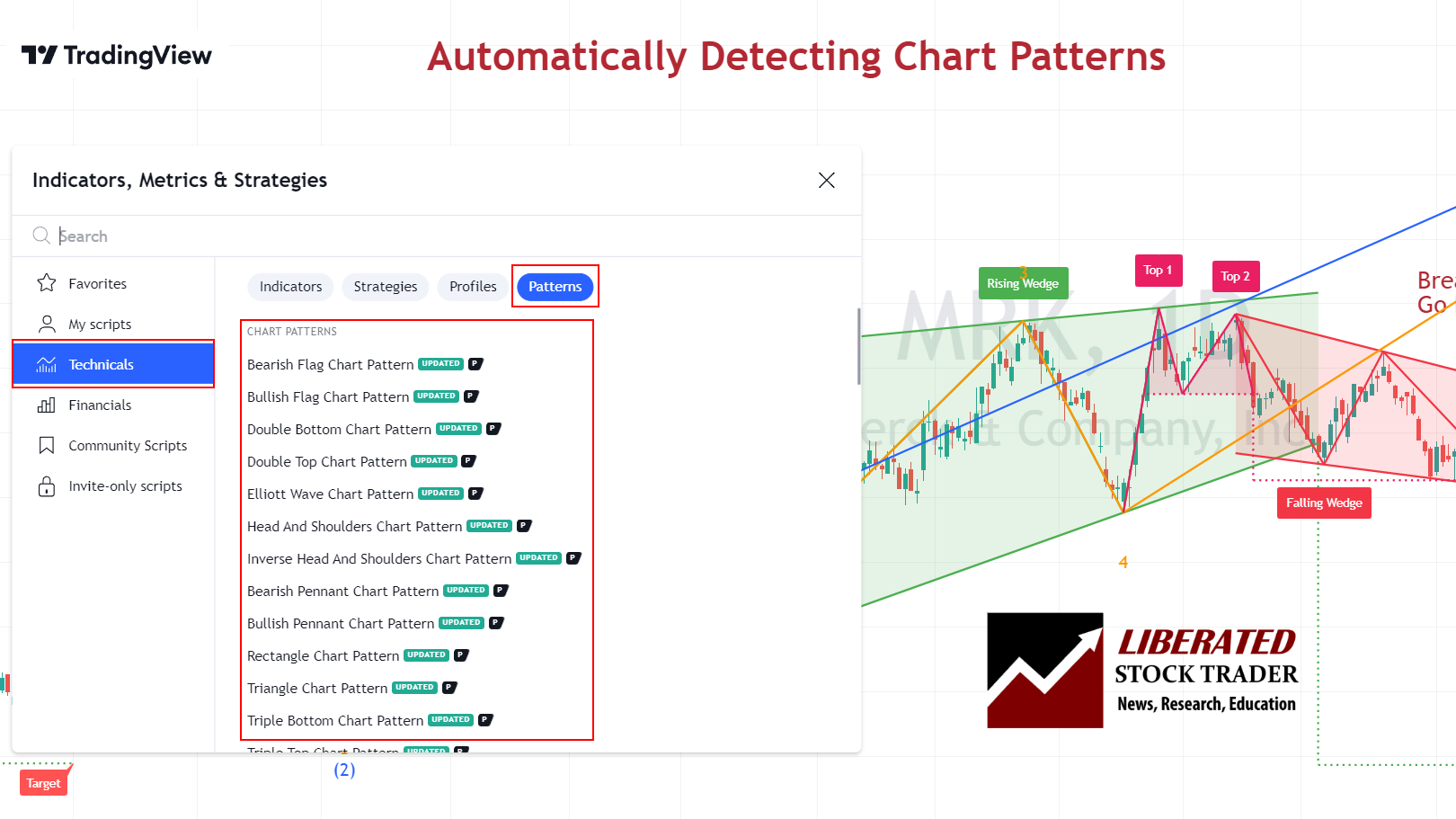
What are the Triple Bottom Pattern Rules?
- The triple bottom pattern usually appears after a downtrend and is seen as a sign that the trend is reversing.
- There must be three distinct bottoms with almost equal low price points within 4%.
- Volume must increase after the third bottom, and a break above the peak between the three bottoms is considered a buy signal.
- When trading with triple bottom patterns, traders should set their stop loss below the neckline.
The Best Triple Bottom Pattern Scanners
There are currently two trading platforms offering triple bottom scanning and screening. TrendSpider and FinViz enable complete market scanning for triple bottoms. Finviz is a good free pattern scanner, whereas TrendSpider enables full backtesting, scanning, and strategy testing for chart patterns.
TrendSpider Triple Bottom Scanning in Action
Scanning for triple bottom patterns with TrendSpider is easy. Visit TrendSpider, select Market Scanner > All of the Following >Chart Pattern > Triple Bottom > Scan, and you will be presented with a list of stocks with triple bottom patterns.
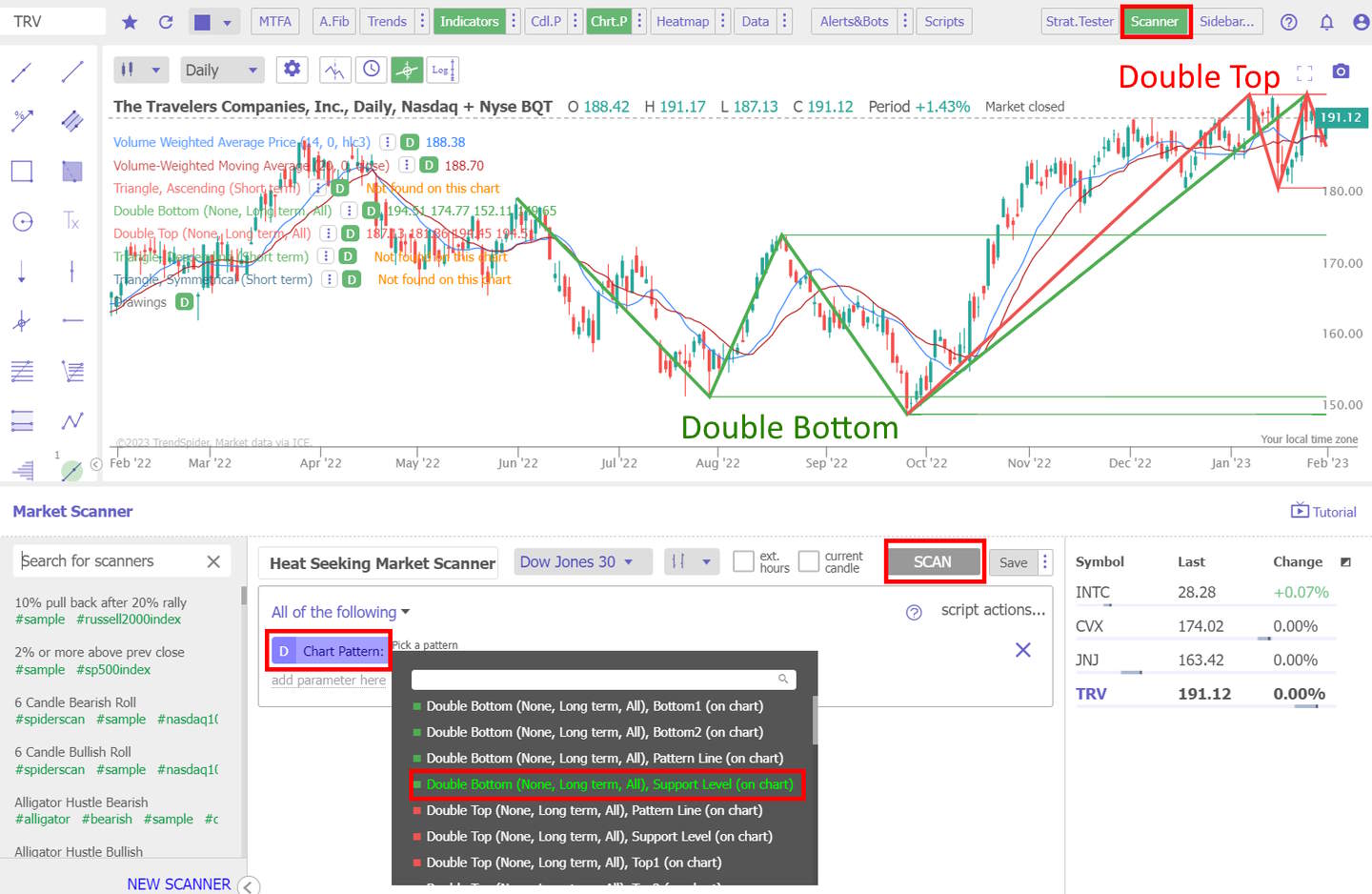
Scan for this Chart Pattern with TrendSpider
Using AI-Driven Technical Analysis with Triple Bottom Patterns
One of the major benefits of using AI-driven technical analysis tools like TrendSpider is the ability to backtest historical data. This allows traders to compare the performance of their strategy over different periods and markets. With TrendSpider, you can go back in time to find stocks exhibiting triple bottom patterns and then use the platform’s advanced analytics tools to analyze how effective this pattern was for trading at any given time. TrendSpider’s AI-driven algorithms also help traders identify the most reliable entry and exit points for triple bottom patterns.
By combining AI-driven technical analysis with traditional charting methods, TrendSpider helps traders take full advantage of market opportunities presented by the triple-bottom pattern. With features such as automated alerts, backtesting, and real-time market data, you can quickly spot and take advantage of triple-bottom patterns as they emerge. In addition, its interactive charts allow traders to analyze various aspects of the pattern without manually drawing each line onto the chart.
How to Find Triple Bottom Pattern Stocks Today
FinViz has a great feature for scanning for triple-bottom patterns. By selecting ” Triple Bottom/Triple Top” as your scan criteria, you can easily find stocks exhibiting this pattern. This is especially useful to traders who want to monitor potential trading opportunities.
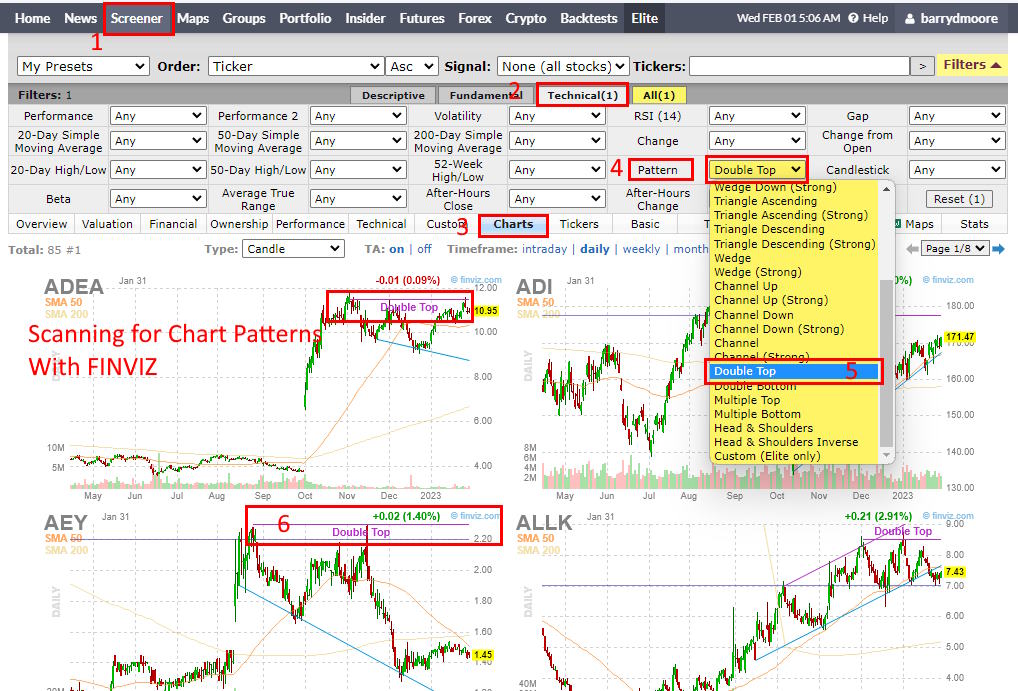
Scan for this Chart Pattern with FinViz
The first step to finding stocks that have potential triple bottom patterns is to select a set of criteria. Finviz offers a range of pre-defined filters and sorting options, enabling traders to quickly narrow their search by sector, industry, market capitalization, and more. After selecting the desired criteria, traders can apply the filter to the Finviz screener.
Once the filter has been applied, traders can then view the results on a chart interface. Depending on the complexity of their search criteria, several stocks may meet the criteria and appear to have potential triple bottom patterns. By clicking on each stock name, traders can open up a chart.
FAQ
Is a triple bottom pattern bearish?
The triple bottom is not bearish; it is a bullish signal in a bull market. It signals with an 87 percent accuracy that the current downward trend may end and could reverse into an upward trend soon.
What are the benefits of trading triple bottoms?
Trading the triple bottom offers traders several advantages over other trading strategies. These include high accuracy and the potential to generate both short-term and long-term profits. This pattern is easy to identify but occurs less frequently than other patterns.
What are the risks of trading a triple bottom?
As with any trading strategy, there are risks associated with trading the triple bottom pattern. These include the 13 percent potential for false signals, which can cause significant losses if not managed properly. Additionally, a trader should know about identifying support and resistance levels to determine when to enter a trade or exit one quickly.
What is the success rate of triple bottom patterns?
The success rate of triple bottom patterns is approximately 87 percent. This means a trader has an 8.7 out of 10 chance of making a profitable trade with the pattern. However, traders should remember that there is still a 17 percent false signal risk associated with this strategy.
Is a triple bottom pattern good?
A triple bottom pattern is very good signal for day traders. It provides an easy and accurate way to identify potential buying opportunities creating high-probability trades. Tom Bulkowski's research confirms an accuracy of 87 percent for triple bottom patterns with an average profit potential of 45%.
Can triple bottoms fail?
Yes, triple bottoms fail approximately 13% of the time during a bull market. Therefore, it's important to understand the risks associated with this strategy. Always use stop losses and take profits when trading patterns to minimize risk and maximize profit potential.
What is the psychology behind the triple bottom pattern?
The triple bottom pattern is a reflection of sentiment. When the market is bearish, investors hesitate to buy stocks at their current prices, resulting in lower volume and slower price movements. Once sentiment improves and buyers outnumber sellers, volume increases, and prices rise. This is why triple bottoms often offer an average profit potential of 45%.
Is a double bottom better than a triple bottom?
Testing has proven that a double bottom is slightly better than a triple bottom pattern. The triple bottom is an excellent chart pattern with a success rate of 87 percent versus the double bottom's 88 percent. Also, a triple bottom average gain is +45 percent versus the double bottom of +50 percent.
What is the opposite of triple bottom?
The opposite of a triple bottom is a triple top. A triple top often occurs after an uptrend, indicating that the momentum has reversed and it's time to sell. The triple bottom and triple top are considered reversal patterns in technical analysis. The average gain for a triple top is usually lower than that of a triple bottom.
How reliable is a triple bottom pattern?
The triple bottom pattern is among the most reliable chart indicators, with success rates of 88 percent during a bull market. During a bear market, double bottoms are much less reliable.
Do triple bottoms hold?
Yes, triple bottom patterns hold 87 percent of the time, according to decades of research compiled by Tom Bulkowski in his book The Encyclopedia of chart patterns.
How to identify triple bottom patterns?
Triple bottom patterns can be identified automatically with TradingView or FinViz. Alternatively, you can manually identify it by looking for three price lows over a period of weeks.
How to measure a triple bottom pattern?
TradingView can automatically measure a triple bottom pattern to set a price target. Alternatively, to measure manually, use an arithmetic chart and plot the distance between the neckline and the bottoms. This distance will be the future price target which you should annotate on the chart.
What is a flawed triple bottom pattern?
A flawed triple bottom pattern is a bullish reversal pattern that doesn't meet all of the criteria for a normal triple bottom pattern. Typically, it occurs when the bottoms do not have an equal low or a non-horizontal neckline.
Is a triple bottom pattern bullish or bearish?
A triple bottom is a proven bullish signal in a bull market. It signals with an 87 percent accuracy that the current downward trend may end and could reverse into an upward trend soon.
